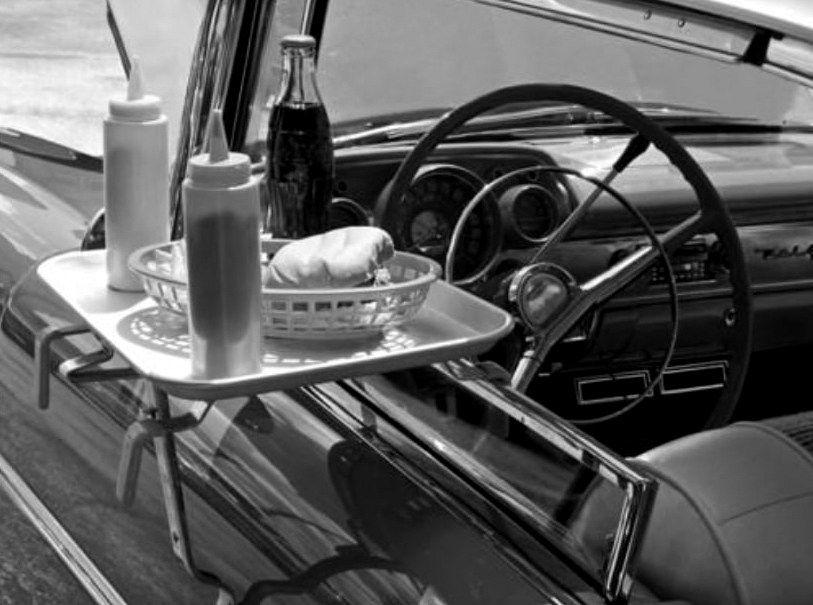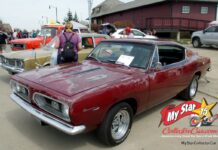The recent plague changed how businesses function in a big way.
Everything is done under whatever state-issued guidelines allow, so bureaucrats amped up and changed the rules whenever they felt the public wasn’t listening to their lectures.
The results were confusing, complicated, and anti-business, but restaurants stepped up with a new-old idea—curbside service.
JERRY SUTHERLAND
Curbside service is a 21st century term for drive-in restaurant. Don’t confuse curbside service with drive-through service at your local burger joint. Drive-in restaurants meant you drove into the parking lot, found a spot, and ordered your food from a real-life person.

The drive-in idea started in the 1920s when more people bought cars, more roads were built, so more people travelled. The drive-in restaurant was a natural consequence of this newfound mobility, because people still had to eat—a quick pit stop at a drive-in restaurant made a lot of sense to these 20th century gypsies.

Drive-ins became a way of life for decades until the turnpikes turned highways into 75 mile per hour speedways. Old roads like Route 66 saw road warrior business disappear overnight, so there were many casualties in the drive-in world—and the motel world. The range of a Model A was limited by its top speed and the roads, but 50s iron had no trouble running at 80 on the new freeways for hundreds of miles.

The drive-ins on the old roads may have disappeared, but they popped up in every small, medium, and large town or city and they became the default hangout for kids and cars. Drive-ins were like old school social media platforms because that’s where you hung out—the cooler your car—the cooler you were.

George Lucas based the classic movie ‘American Graffiti’ on his own experiences in 60s California so it’s no surprise he included a drive-in as a focal point for the local kids. Battles were won and lost on the street next to the drive-in, but there were more social battles at the drive-in. Your status was determined by how you rolled, so Toad’s Vespa scooter put him at the bottom of the food chain and Milner’s ’32 Ford put him at the top.

The earliest drive-in restaurants put their carhops (servers) on roller skates to speed up the service, but these skates also created some spectacular mishaps with milkshakes and other stuff when a carhop bit the dust.

They had a few ways to provide service at a drive-in. If the carhops didn’t pick you off when you rolled in, you turned on your lights to get their attention. You turned them on again when you wanted to leave.

They’d take your order then return with a tray–that’s when you’d be asked to roll down your window and hope it didn’t collapse under the weight. A collapsed window was almost as funny as a roller skate wipeout in the world of drive-in mishaps.

Technology changed the drive-in restaurant game because the headlight signal for service was replaced by a standalone intercom setup where you could order from your car window—similar to the drive-through system you see everywhere.

That brings us to today. Phone apps mean you can call your local restaurant and have your order waiting in the parking lot. It’s not a stretch to imagine a world where kids and cars gather at a drive-in restaurant where you order through your phone, tell your buddies where you are and wait for a carhop.

That’s why the drive-in restaurant could make a comeback.
By: Jerry Sutherland
Jerry Sutherland is a veteran automotive writer with a primary focus on the collector car hobby. His work has been published in many outlets and publications, including the National Post, Calgary Herald, Edmonton Journal, Ottawa Citizen, Montreal Gazette, Saskatoon StarPhoenix, Regina Leader-Post, Vancouver Sun and The Truth About Cars. He is also a regular contributor to Auto Roundup Publications.
- CLICK HERE TO SIGN UP FOR THE NEWSLETTER
- CLICK HERE to Like us on Facebook
- CLICK HERE to Follow us on Twitter
- CLICK HERE to Follow us on Pinterest
Please re-post this if you like this article.
























































